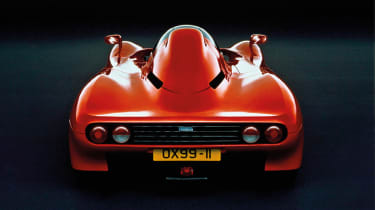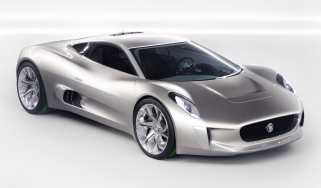Yamaha OX99-11 – Dead on arrival
Drawing comparisons with McLaren’s F1, Yamaha’s $1m OX99-11 supercar promised light weight, V12 power and a central driving position

In the late ’80s Yamaha decided to celebrate its new role as a Formula 1 engine supplier by making a hardcore supercar, powered by a house-trained version of its racing engine. The initiative was pushed by the company’s promo-seeking sporting goods division and, after a false start with a sport prototype-alike design from a firm in Germany, Yamaha hired International Automotive Design in Sussex to create something more radical.
Working in league with Ypsilon Technology, the Milton Keynes-based Yamaha subsidiary that built the F1 engines, and to a radical exterior style created by Mooncraft in Japan, IAD confected a tantalising spec for this unique machine. It started with the engine, a de-tuned version of the OX99 racing V12, hence the car’s name, incorporated as a load-bearing part of the car. In road spec it would make 400bhp at a lively 10,000rpm. Not heaps by modern standards, but adequate when the car’s carbonfibre tub and aluminium panels made it a 1150-kilo lightweight.
A conventional six-speed manual ’box and rear-wheel drive promised uncomplicated pleasures, while suspension design followed race car principles with inboard springs and dampers worked by pushrods. Damping and ride height would be fully adjustable. To hammer home the racing connection, the driver sat centrally with a small space behind for a ‘pillion’ passenger, their legs canted down one side of the seat in front. Access was by a single gull-wing door that lifted out a slice of the whole canopy, and the interior was wilfully minimal, though the driver and their tightly packed passenger would at least feel the benefit of air conditioning.
> Lexus LFA: history, review and specs of an icon
IAD completed the first prototype in 1991 and conducted shakedown tests at Millbrook Proving Ground under the cover of darkness to minimise the chances of anyone papping this insane-looking machine. Satisfied that the concept worked as intended, it built another two cars ahead of a press launch in 1992, at which Yamaha said it would make 20 to 30 cars a year in the old Brabham factory in Chessington. The price was not confirmed, though it was expected to be as much as $1million, or over £500,000 in 1992, and the company was keen to emphasise that acceleration and driveability were greater development priorities than top speed.
You might think all this sounds very similar to another early ’90s, motorsport-related supercar. Free-revving V12, central driving position, emphasis on more than just numbers. Yamaha even brought in March co-founder Robin Herd to provide the team with a Gordon Murray-style, motorsport-hardened engineering guru. But where the McLaren F1 made it to production, the OX99-11 was not so fortunate. Soon after the car was revealed to the media, IAD and Yamaha fell out, the project was hauled back in-house, and shortly afterwards the Japanese economy tanked. As the bubble burst and belts were tightened, the OX99-11 was an obvious sacrifice and the project was cancelled.
All three OX99-11 prototypes appear to have survived and one was up for sale in Japan just last year, with a price tag of $1.3m (£1m). As for Yamaha, it never achieved its dream of making a road car, and its F1 efforts were conspicuously without success. On the plus side, since the ill-fated OX99-11 its contribution to other firms’ road car engines has been significant, including the sweetly spinning 1.7-litre four-cylinder in the Ford Puma and the glorious V10 at the front of the Lexus LFA.






